Page 1331 of 3342
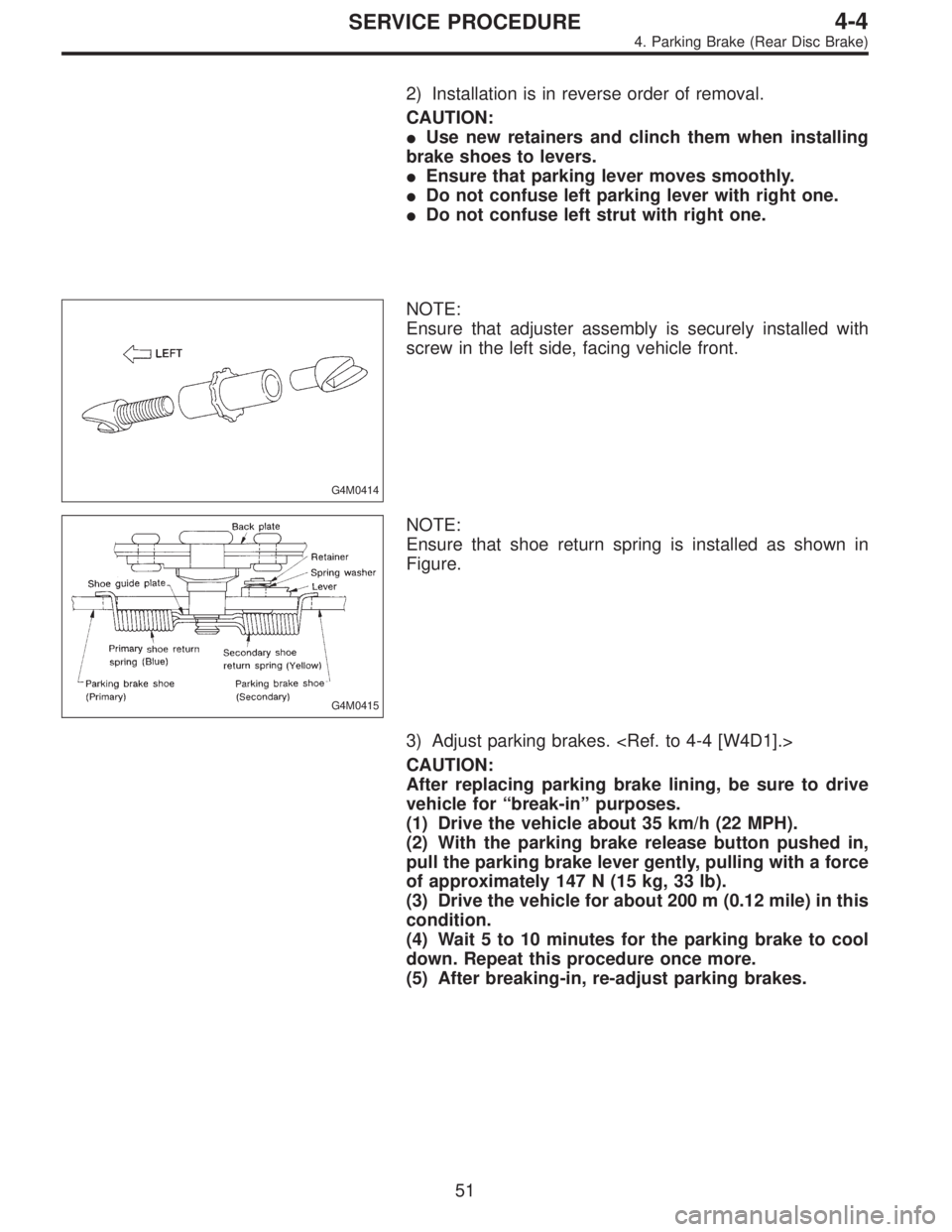
2) Installation is in reverse order of removal.
CAUTION:
�Use new retainers and clinch them when installing
brake shoes to levers.
�Ensure that parking lever moves smoothly.
�Do not confuse left parking lever with right one.
�Do not confuse left strut with right one.
G4M0414
NOTE:
Ensure that adjuster assembly is securely installed with
screw in the left side, facing vehicle front.
G4M0415
NOTE:
Ensure that shoe return spring is installed as shown in
Figure.
3) Adjust parking brakes.
CAUTION:
After replacing parking brake lining, be sure to drive
vehicle for“break-in”purposes.
(1) Drive the vehicle about 35 km/h (22 MPH).
(2) With the parking brake release button pushed in,
pull the parking brake lever gently, pulling with a force
of approximately 147 N (15 kg, 33 lb).
(3) Drive the vehicle for about 200 m (0.12 mile) in this
condition.
(4) Wait 5 to 10 minutes for the parking brake to cool
down. Repeat this procedure once more.
(5) After breaking-in, re-adjust parking brakes.
51
4-4SERVICE PROCEDURE
4. Parking Brake (Rear Disc Brake)
Page 1332 of 3342
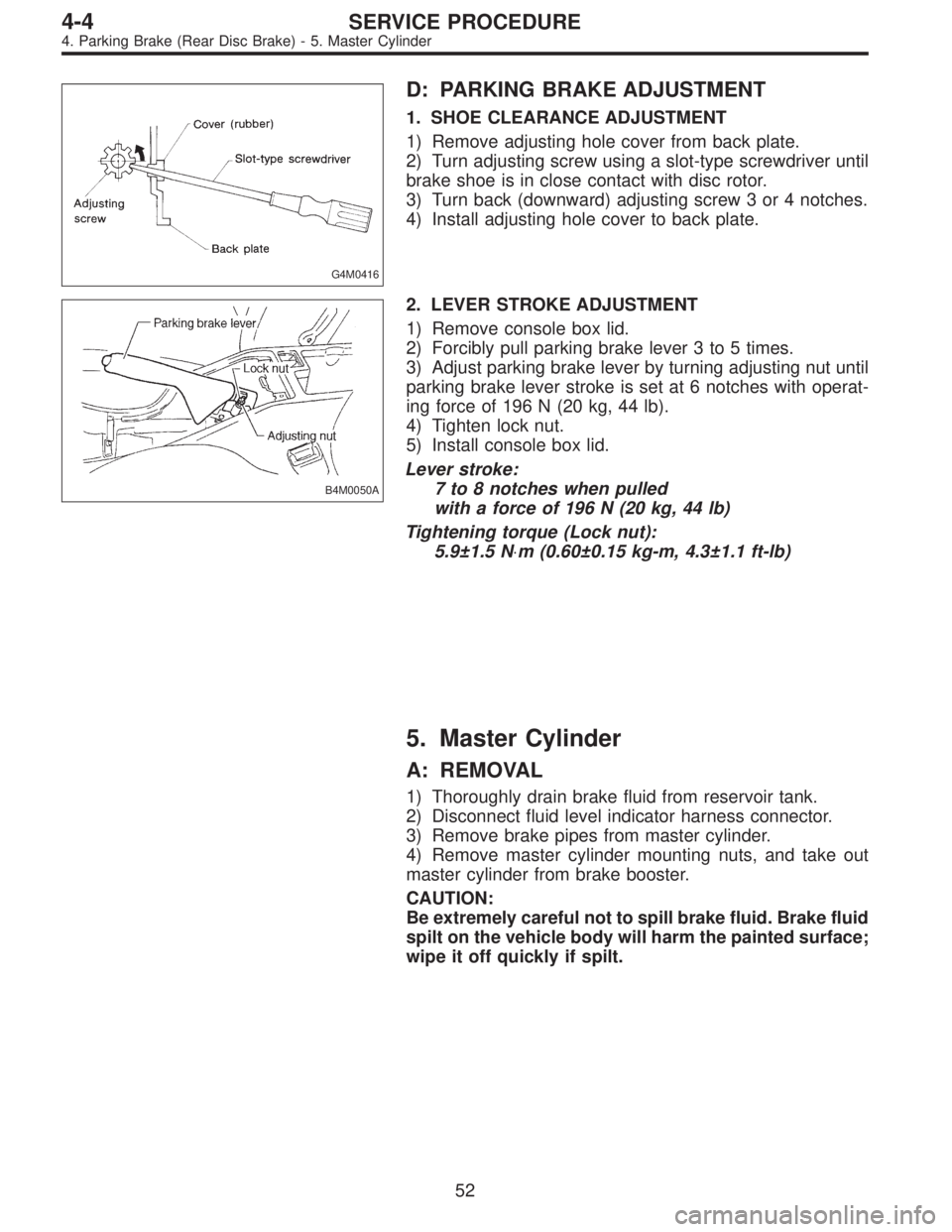
G4M0416
D: PARKING BRAKE ADJUSTMENT
1. SHOE CLEARANCE ADJUSTMENT
1) Remove adjusting hole cover from back plate.
2) Turn adjusting screw using a slot-type screwdriver until
brake shoe is in close contact with disc rotor.
3) Turn back (downward) adjusting screw 3 or 4 notches.
4) Install adjusting hole cover to back plate.
B4M0050A
2. LEVER STROKE ADJUSTMENT
1) Remove console box lid.
2) Forcibly pull parking brake lever 3 to 5 times.
3) Adjust parking brake lever by turning adjusting nut until
parking brake lever stroke is set at 6 notches with operat-
ing force of 196 N (20 kg, 44 lb).
4) Tighten lock nut.
5) Install console box lid.
Lever stroke:
7 to 8 notches when pulled
with a force of 196 N (20 kg, 44 lb)
Tightening torque (Lock nut):
5.9±1.5 N⋅m (0.60±0.15 kg-m, 4.3±1.1 ft-lb)
5. Master Cylinder
A: REMOVAL
1) Thoroughly drain brake fluid from reservoir tank.
2) Disconnect fluid level indicator harness connector.
3) Remove brake pipes from master cylinder.
4) Remove master cylinder mounting nuts, and take out
master cylinder from brake booster.
CAUTION:
Be extremely careful not to spill brake fluid. Brake fluid
spilt on the vehicle body will harm the painted surface;
wipe it off quickly if spilt.
52
4-4SERVICE PROCEDURE
4. Parking Brake (Rear Disc Brake) - 5. Master Cylinder
Page 1333 of 3342

G4M0416
D: PARKING BRAKE ADJUSTMENT
1. SHOE CLEARANCE ADJUSTMENT
1) Remove adjusting hole cover from back plate.
2) Turn adjusting screw using a slot-type screwdriver until
brake shoe is in close contact with disc rotor.
3) Turn back (downward) adjusting screw 3 or 4 notches.
4) Install adjusting hole cover to back plate.
B4M0050A
2. LEVER STROKE ADJUSTMENT
1) Remove console box lid.
2) Forcibly pull parking brake lever 3 to 5 times.
3) Adjust parking brake lever by turning adjusting nut until
parking brake lever stroke is set at 6 notches with operat-
ing force of 196 N (20 kg, 44 lb).
4) Tighten lock nut.
5) Install console box lid.
Lever stroke:
7 to 8 notches when pulled
with a force of 196 N (20 kg, 44 lb)
Tightening torque (Lock nut):
5.9±1.5 N⋅m (0.60±0.15 kg-m, 4.3±1.1 ft-lb)
5. Master Cylinder
A: REMOVAL
1) Thoroughly drain brake fluid from reservoir tank.
2) Disconnect fluid level indicator harness connector.
3) Remove brake pipes from master cylinder.
4) Remove master cylinder mounting nuts, and take out
master cylinder from brake booster.
CAUTION:
Be extremely careful not to spill brake fluid. Brake fluid
spilt on the vehicle body will harm the painted surface;
wipe it off quickly if spilt.
52
4-4SERVICE PROCEDURE
4. Parking Brake (Rear Disc Brake) - 5. Master Cylinder
Page 1334 of 3342
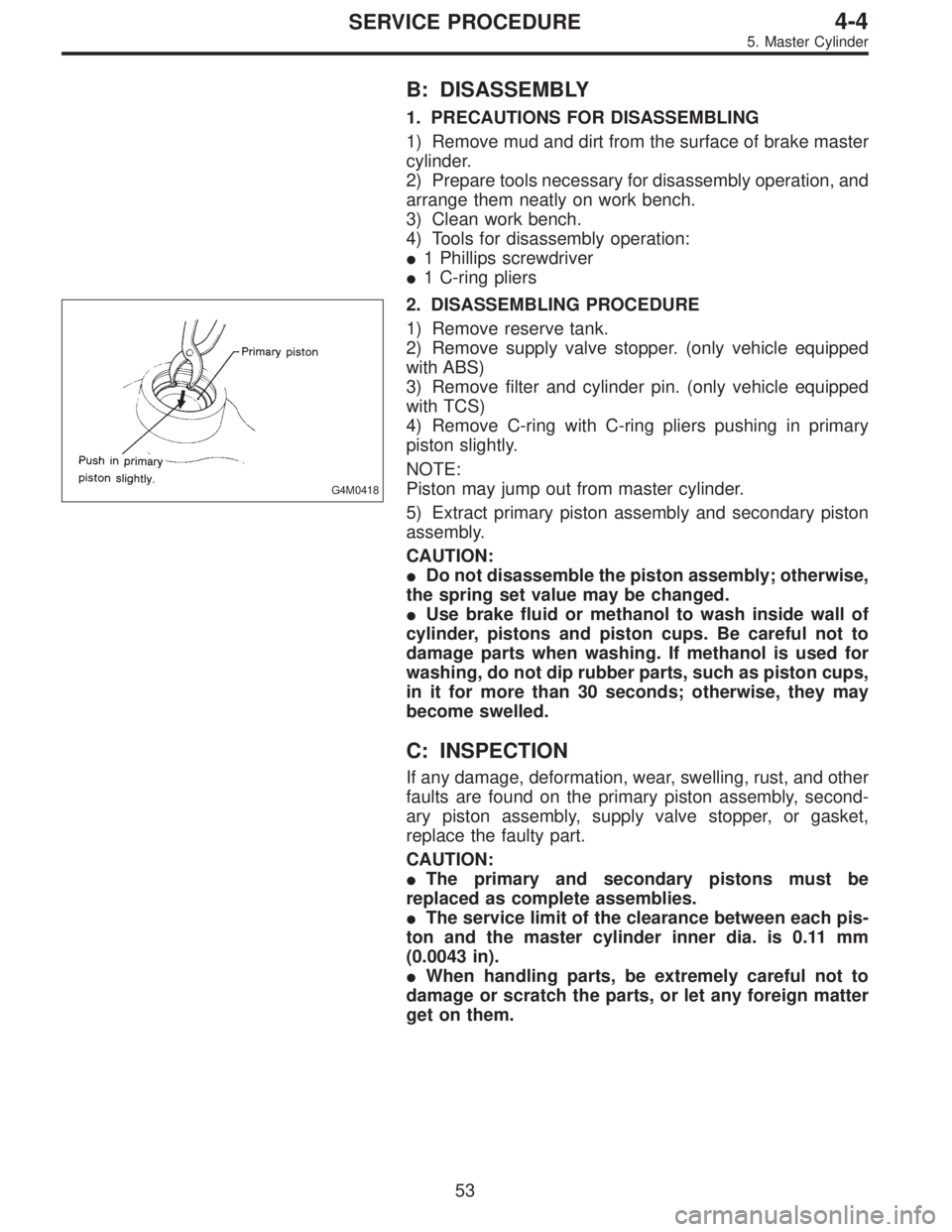
B: DISASSEMBLY
1. PRECAUTIONS FOR DISASSEMBLING
1) Remove mud and dirt from the surface of brake master
cylinder.
2) Prepare tools necessary for disassembly operation, and
arrange them neatly on work bench.
3) Clean work bench.
4) Tools for disassembly operation:
�1 Phillips screwdriver
�1 C-ring pliers
G4M0418
2. DISASSEMBLING PROCEDURE
1) Remove reserve tank.
2) Remove supply valve stopper. (only vehicle equipped
with ABS)
3) Remove filter and cylinder pin. (only vehicle equipped
with TCS)
4) Remove C-ring with C-ring pliers pushing in primary
piston slightly.
NOTE:
Piston may jump out from master cylinder.
5) Extract primary piston assembly and secondary piston
assembly.
CAUTION:
�Do not disassemble the piston assembly; otherwise,
the spring set value may be changed.
�Use brake fluid or methanol to wash inside wall of
cylinder, pistons and piston cups. Be careful not to
damage parts when washing. If methanol is used for
washing, do not dip rubber parts, such as piston cups,
in it for more than 30 seconds; otherwise, they may
become swelled.
C: INSPECTION
If any damage, deformation, wear, swelling, rust, and other
faults are found on the primary piston assembly, second-
ary piston assembly, supply valve stopper, or gasket,
replace the faulty part.
CAUTION:
�The primary and secondary pistons must be
replaced as complete assemblies.
�The service limit of the clearance between each pis-
ton and the master cylinder inner dia. is 0.11 mm
(0.0043 in).
�When handling parts, be extremely careful not to
damage or scratch the parts, or let any foreign matter
get on them.
53
4-4SERVICE PROCEDURE
5. Master Cylinder
Page 1335 of 3342
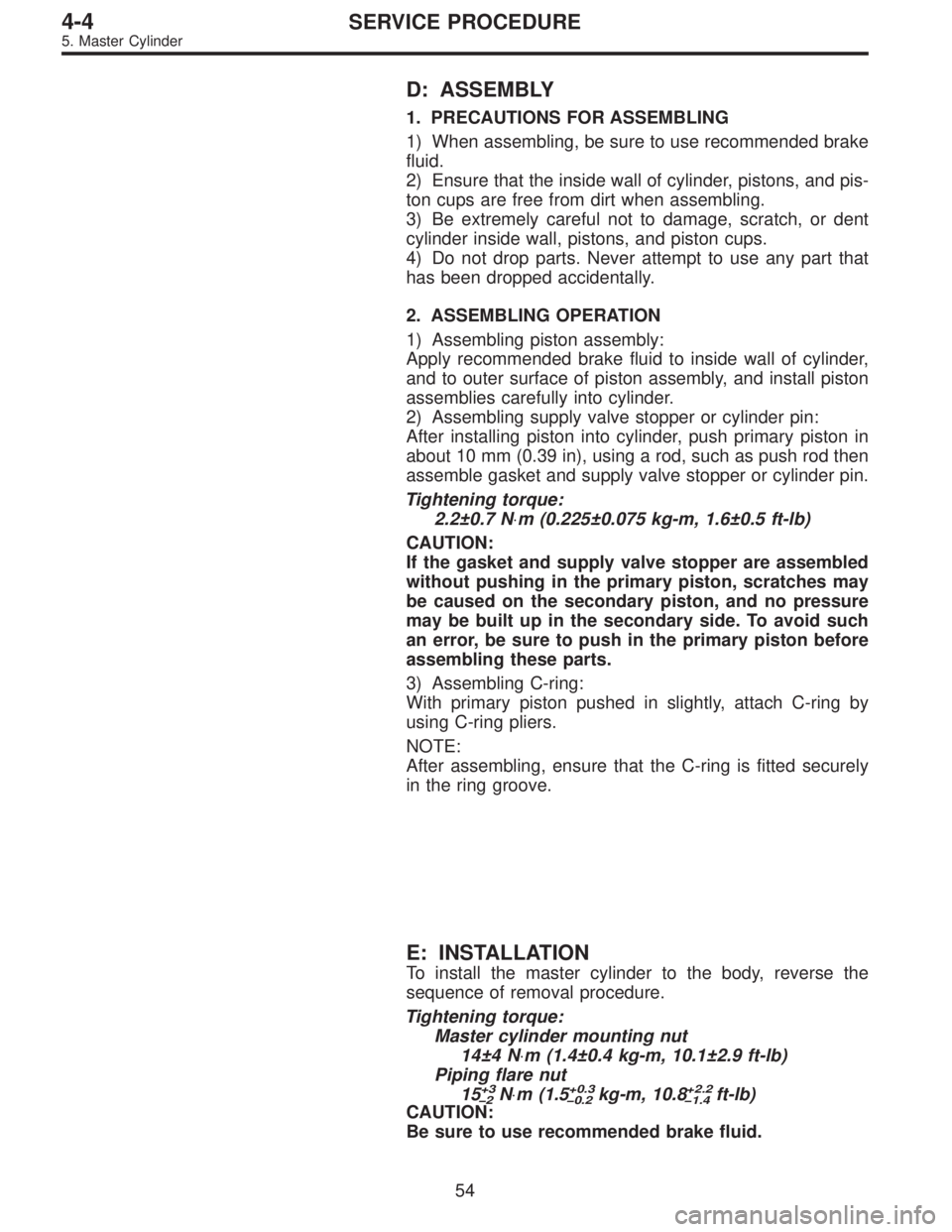
D: ASSEMBLY
1. PRECAUTIONS FOR ASSEMBLING
1) When assembling, be sure to use recommended brake
fluid.
2) Ensure that the inside wall of cylinder, pistons, and pis-
ton cups are free from dirt when assembling.
3) Be extremely careful not to damage, scratch, or dent
cylinder inside wall, pistons, and piston cups.
4) Do not drop parts. Never attempt to use any part that
has been dropped accidentally.
2. ASSEMBLING OPERATION
1) Assembling piston assembly:
Apply recommended brake fluid to inside wall of cylinder,
and to outer surface of piston assembly, and install piston
assemblies carefully into cylinder.
2) Assembling supply valve stopper or cylinder pin:
After installing piston into cylinder, push primary piston in
about 10 mm (0.39 in), using a rod, such as push rod then
assemble gasket and supply valve stopper or cylinder pin.
Tightening torque:
2.2±0.7 N⋅m (0.225±0.075 kg-m, 1.6±0.5 ft-lb)
CAUTION:
If the gasket and supply valve stopper are assembled
without pushing in the primary piston, scratches may
be caused on the secondary piston, and no pressure
may be built up in the secondary side. To avoid such
an error, be sure to push in the primary piston before
assembling these parts.
3) Assembling C-ring:
With primary piston pushed in slightly, attach C-ring by
using C-ring pliers.
NOTE:
After assembling, ensure that the C-ring is fitted securely
in the ring groove.
E: INSTALLATION
To install the master cylinder to the body, reverse the
sequence of removal procedure.
Tightening torque:
Master cylinder mounting nut
14±4 N⋅m (1.4±0.4 kg-m, 10.1±2.9 ft-lb)
Piping flare nut
15
+3
�2N⋅m (1.5+0.3
�0.2kg-m, 10.8+2.2
�1.4ft-lb)
CAUTION:
Be sure to use recommended brake fluid.
54
4-4SERVICE PROCEDURE
5. Master Cylinder
Page 1336 of 3342
6. Brake Booster
A: REMOVAL
1) Remove or disconnect the following parts at engine
compartment.
(1) Disconnect connector for brake fluid level indicator.
(2) Remove brake pipes from master cylinder.
(3) Remove master cylinder installing nuts.
(4) Disconnect vacuum hose from brake booster.
2) Remove the following parts from the pedal bracket.
(1) Snap pin and clevis pin
(2) Four brake booster installing nuts
3) Remove brake booster while shunning brake pipes.
B4M0117A
B: INSTALLATION
1) Mount brake booster in position.
2) Connect operating rod to brake pedal with clevis pin
and snap pin.
�
1Clevis pin
�
2Snap pin
�
3Operating rod
G4M0420
3) Connect vacuum hose to brake booster.
4) Mount master cylinder onto brake booster.
5) Connect brake pipes to master cylinder.
6) Connect electric connector for brake fluid level indica-
tor.
55
4-4SERVICE PROCEDURE
6. Brake Booster
Page 1337 of 3342
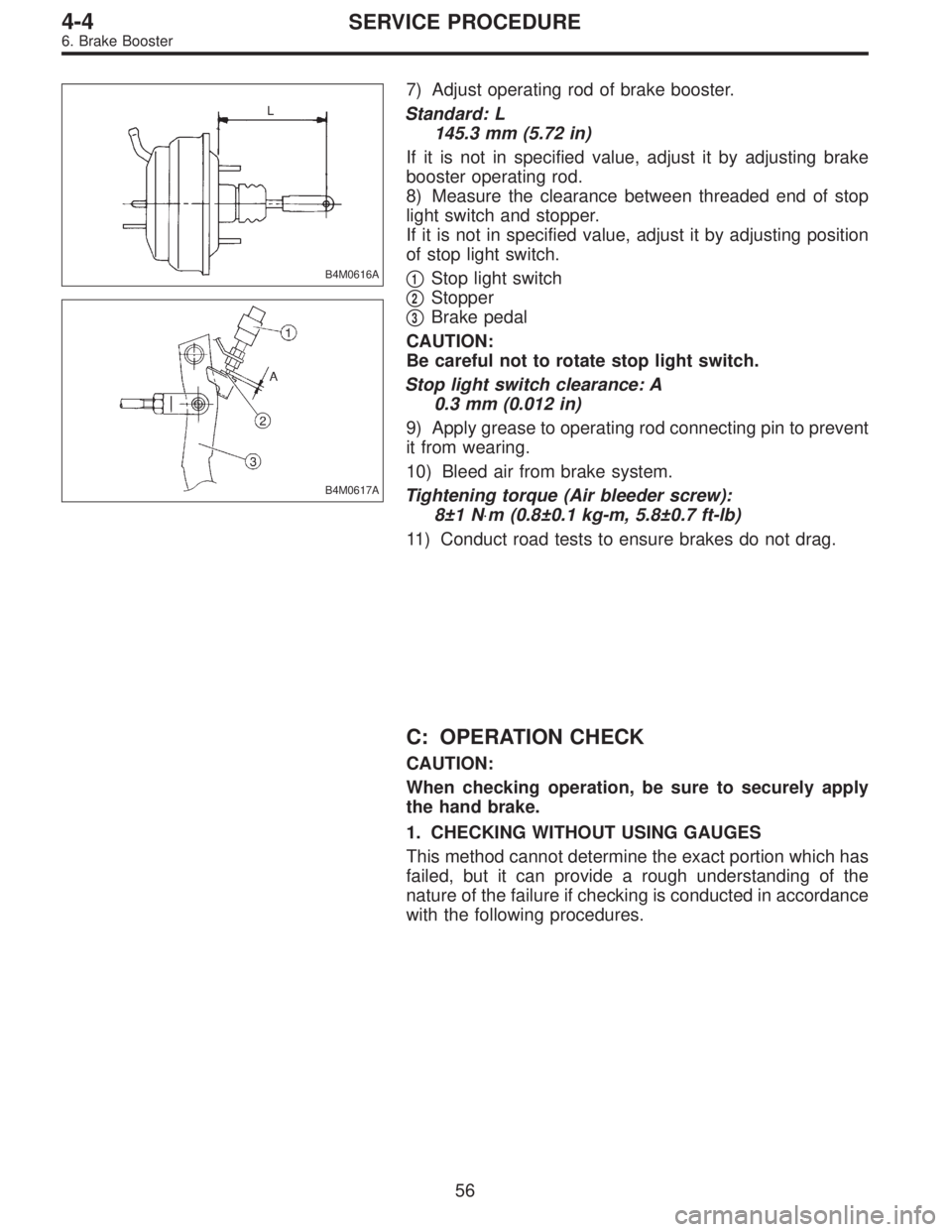
B4M0616A
B4M0617A
7) Adjust operating rod of brake booster.
Standard: L
145.3 mm (5.72 in)
If it is not in specified value, adjust it by adjusting brake
booster operating rod.
8) Measure the clearance between threaded end of stop
light switch and stopper.
If it is not in specified value, adjust it by adjusting position
of stop light switch.
�
1Stop light switch
�
2Stopper
�
3Brake pedal
CAUTION:
Be careful not to rotate stop light switch.
Stop light switch clearance: A
0.3 mm (0.012 in)
9) Apply grease to operating rod connecting pin to prevent
it from wearing.
10) Bleed air from brake system.
Tightening torque (Air bleeder screw):
8±1 N⋅m (0.8±0.1 kg-m, 5.8±0.7 ft-lb)
11) Conduct road tests to ensure brakes do not drag.
C: OPERATION CHECK
CAUTION:
When checking operation, be sure to securely apply
the hand brake.
1. CHECKING WITHOUT USING GAUGES
This method cannot determine the exact portion which has
failed, but it can provide a rough understanding of the
nature of the failure if checking is conducted in accordance
with the following procedures.
56
4-4SERVICE PROCEDURE
6. Brake Booster
Page 1338 of 3342
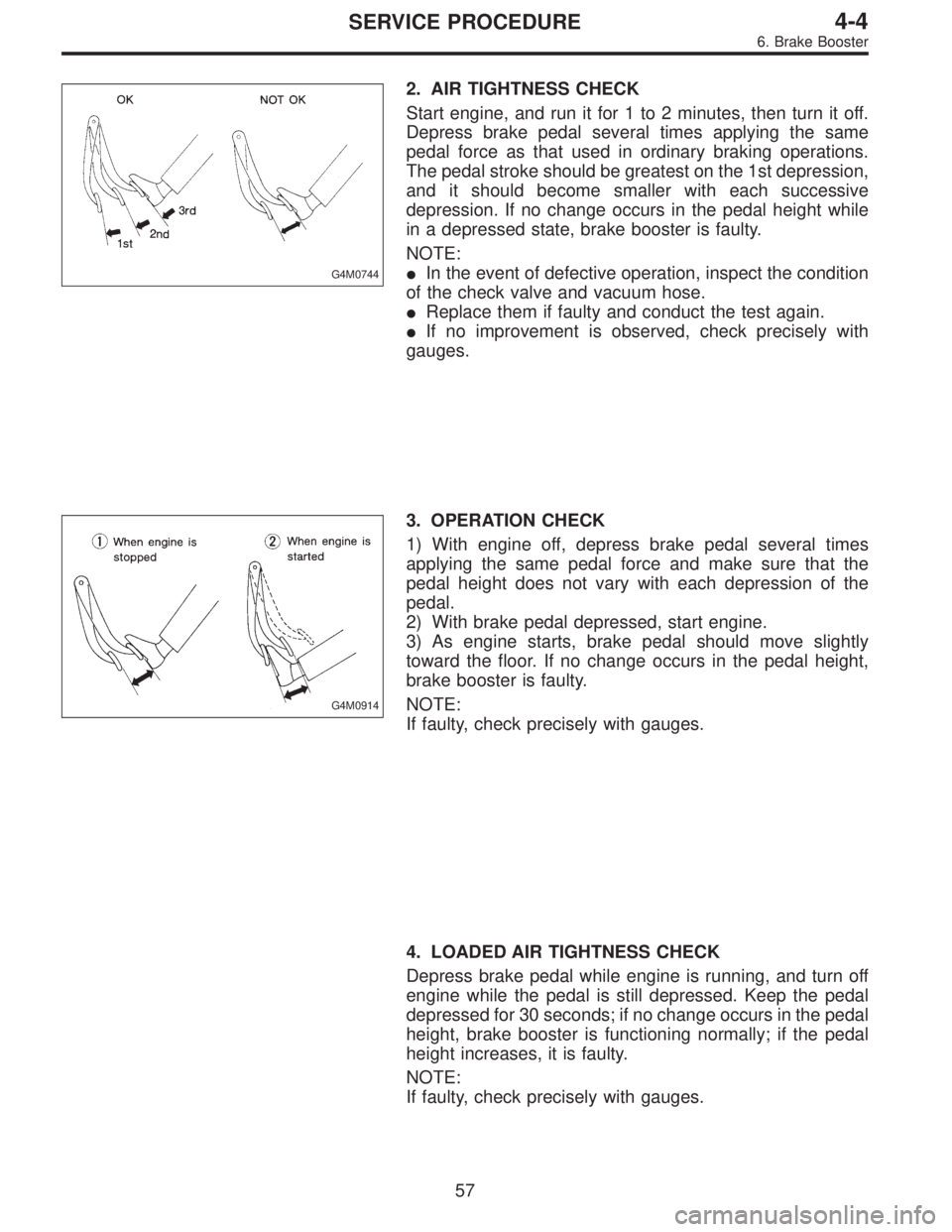
G4M0744
2. AIR TIGHTNESS CHECK
Start engine, and run it for 1 to 2 minutes, then turn it off.
Depress brake pedal several times applying the same
pedal force as that used in ordinary braking operations.
The pedal stroke should be greatest on the 1st depression,
and it should become smaller with each successive
depression. If no change occurs in the pedal height while
in a depressed state, brake booster is faulty.
NOTE:
�In the event of defective operation, inspect the condition
of the check valve and vacuum hose.
�Replace them if faulty and conduct the test again.
�If no improvement is observed, check precisely with
gauges.
G4M0914
3. OPERATION CHECK
1) With engine off, depress brake pedal several times
applying the same pedal force and make sure that the
pedal height does not vary with each depression of the
pedal.
2) With brake pedal depressed, start engine.
3) As engine starts, brake pedal should move slightly
toward the floor. If no change occurs in the pedal height,
brake booster is faulty.
NOTE:
If faulty, check precisely with gauges.
4. LOADED AIR TIGHTNESS CHECK
Depress brake pedal while engine is running, and turn off
engine while the pedal is still depressed. Keep the pedal
depressed for 30 seconds; if no change occurs in the pedal
height, brake booster is functioning normally; if the pedal
height increases, it is faulty.
NOTE:
If faulty, check precisely with gauges.
57
4-4SERVICE PROCEDURE
6. Brake Booster